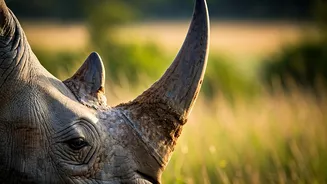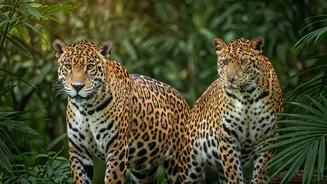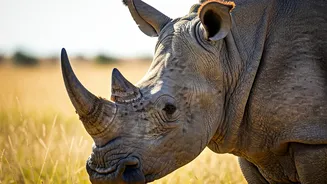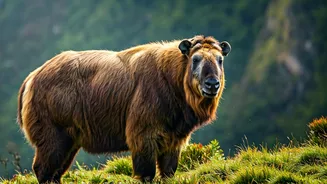Poor Eyesight, Strong Senses
Contrary to what one might assume, rhinos don't have the best vision. Their eyesight is actually quite poor, making it difficult for them to see clearly
at a distance. However, they compensate for this visual limitation with highly developed senses of hearing and smell. Rhinos boast incredibly sensitive noses that allow them to detect a range of scents, which is crucial for finding food, recognizing other rhinos, and avoiding predators. Their keen hearing also helps them navigate their environment and stay aware of potential dangers, demonstrating how these animals rely on their senses for survival.
Communication: Sounds and Smells
Rhinos, though often perceived as solitary creatures, engage in a complex form of communication using both sounds and smells. They utilize a variety of vocalizations, ranging from snorts and trumpets to more subtle grunts, to convey different messages to each other. These sounds can signal warnings, establish territory, or attract potential mates. Moreover, rhinos are masters of scent marking. They deposit urine and dung in strategic locations to leave olfactory messages. These scent markers provide vital information about the rhino's presence, age, and reproductive status, creating an invisible network of communication within their habitat.
Grey, Not Black/White
Despite the common association with the colors black and white, rhinos are actually grey. The misconception arises from their appearance in different environments and the way they were initially described. The term “white rhino” is believed to have originated from the Afrikaans word “wyd,” meaning wide, which referred to their broad mouths. Early English settlers misinterpreted this and thought they were describing the rhino’s color. Both black and white rhinos have grey skin. The varying shades of grey can sometimes be influenced by the soil rhinos roll in for mud baths, but their inherent color is consistently a shade of grey, showcasing a linguistic misunderstanding that has persisted over time.
Rhino Horn Composition
The iconic horn of a rhino is composed of keratin, the same protein that makes up human fingernails and hair. This horn grows continuously throughout their lives, and is not made of bone. It starts growing from the skin on the rhino's snout, and each individual strand of hair becomes compacted to create the horn. This unique structure distinguishes the rhino from other animals. The horn's primary function includes defense, but it can also be used for digging, foraging, and establishing dominance. Unfortunately, the horn's composition has also made them targets of illegal poaching, creating an ongoing threat to their survival.
Mostly Plant-Eaters
Rhinos are primarily herbivores, meaning that their diet mainly consists of plants. They consume a variety of vegetation, including grasses, leaves, and twigs, depending on their species and habitat. This plant-based diet plays a vital role in their overall health and well-being, providing essential nutrients and energy. Their digestive system is specifically adapted to efficiently extract nutrients from these fibrous materials. Despite their size, rhinos have a relatively simple digestive system, which makes them highly dependent on access to a consistent supply of quality plant matter, making them key contributors to their ecosystems.
Bulls, Cows, and Calves
Similar to other mammal species, rhinos have distinct terms for males, females, and their young. Male rhinos are called bulls, while females are referred to as cows. Their offspring are known as calves. This terminology helps clarify the rhino's social structure and familial bonds. The relationships within these groups also vary between species. Some rhinos, like the white rhino, are more social and live in small family units, while others, like the black rhino, are typically solitary, with the exception of mothers and calves. Understanding the dynamics of these groups allows us to get a better appreciation of these animals.
Mud Baths for Health
Rhinos regularly take mud baths. This is an essential behavior for maintaining their health and well-being. The mud acts as a natural sunscreen, providing protection from the harsh sun and preventing sunburn. The mud also helps to regulate their body temperature, keeping them cool in the heat. Furthermore, the mud offers a natural insect repellent. The mud coating provides a barrier against biting insects that can spread disease. By rolling in mud, rhinos essentially create a protective shield, contributing to their survival in the wild, showcasing their understanding of self-care through this routine.








